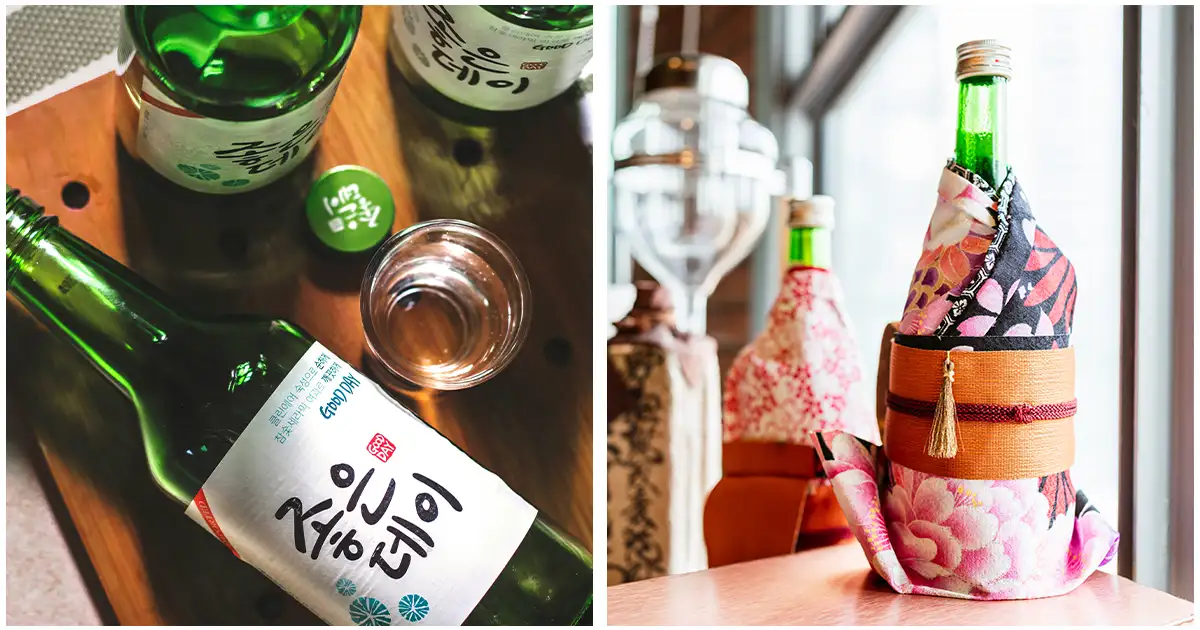The Difference Between Soju and Sake

July 29, 2024

What We’ll Cover in This Piece:
The Basics of Soju

Soju, often affectionately referred to as the "Korean vodka," is deeply ingrained in Korean culture and cuisine, embodying centuries of tradition and conviviality. For restaurant, bar, and small business owners, understanding the intricacies of soju is essential for diversifying beverage offerings and catering to a growing audience of adventurous drinkers.
We’ll review the basics below, but be sure to check out our comprehensive guide on What Is Soju?
Introduction to Soju
Originating in Korea during the thirteenth century, soju's roots are intertwined with the country's tumultuous history and vibrant culinary landscape. Crafted initially from grains like rice, wheat, or barley, soju’s modern variations may incorporate other ingredients, including sweet potatoes and tapioca, to create unique flavor profiles.
Production Process
Soju production involves a meticulous process that begins with fermentation, where the selected grains are fermented with water and yeast to produce a mash. This mash is then distilled, separating alcohol from the fermented mixture, resulting in a clear, potent liquid with a distinctively smooth taste.
Flavor Profile
One of the defining characteristics of soju is its clean and neutral flavor profile, often likened to vodka but with a subtle sweetness and smoothness. Unlike some spirits that boast bold or complex flavors, soju's simplicity makes it incredibly versatile, allowing it to complement a wide range of dishes without overpowering the palate.
Cultural Significance
In Korean culture, soju is the quintessential social lubricant, fostering camaraderie and celebration among friends and family. Its presence is ubiquitous at gatherings, from casual meals to festive occasions, where it is often enjoyed in small shot glasses or mixed in refreshing cocktails.
Implications for Your Establishment
For restaurant, bar, and small business owners, incorporating soju into your beverage offerings can be a strategic move to attract new customers. Its versatility makes it an ideal addition to any menu, whether as a standalone spirit, a base for creative cocktails, or a pairing for Korean-inspired dishes.
The Basics of Sake

Sake, also known as nihonshu, is Japan's renowned rice wine, revered for its elegance, complexity, and deep cultural significance. Much like soju can teach your guests about Korean drinking culture, sake offers an opportunity to add something to your beverage menu that gives patrons a glimpse into Japan's rich heritage and craftsmanship.
Introduction to Sake
Sake's origins date back a millennium, and its production has evolved alongside Japan's cultural and historical landscape. Crafted exclusively from rice, water, yeast, and koji mold, sake undergoes a meticulous brewing process that transforms simple ingredients into a beverage of unparalleled depth and sophistication.
Production Process
Unlike soju, which undergoes distillation, sake is brewed through a unique fermentation process that involves multiple stages of rice polishing, soaking, steaming, fermentation, and pressing. Each step is carefully orchestrated to extract the purest essence from the rice grains, resulting in a drink that reflects the skill and dedication of its brewers.
Flavor Profile
Sake's flavor profile is as diverse as the regions and breweries that produce it, ranging from crisp and dry to rich and umami-laden. Factors such as rice variety, water source, yeast strain, and brewing techniques all contribute to the final flavor profile, offering discerning drinkers a kaleidoscope of sensory experiences.
Cultural Significance
In Japanese culture, sake holds a sacred place in rituals, ceremonies, and celebrations, symbolizing purity, harmony, and hospitality. Its consumption is steeped in tradition, with customs and etiquettes reflecting the reverence and respect accorded to this beverage.
What Are the Distinct Differences Between Soju and Sake?
Now that we’ve covered the basics, we can start to dig into the differences between soju and sake because they are unique and individual in their own ways. Understanding the difference between soju and sake requires a deeper look at their core characteristics. By examining these spirits through various lenses, restaurants, bars, and small business owners can better appreciate their unique attributes and make informed decisions about incorporating them into their offerings. Let’s analyze critical aspects such as alcohol content, ingredients, production processes, serving styles, and culinary pairings.
Alcohol Content
Soju: Typically, soju contains an alcohol content ranging from sixteen percent to twenty-five percent, making it a relatively mild spirit compared to other distilled liquors. This lower alcohol content makes soju an accessible choice for a broad audience, appealing to those who enjoy a lighter yet flavorful drink. It is ideal for social settings where prolonged drinking is daily, such as casual dinners or festive gatherings.
Sake: Sake usually has an alcohol content between fifteen and twenty percent. Despite being brewed and not distilled, sake's alcohol level is comparable to soju's. The variance in alcohol content within sake itself can influence its flavor and mouthfeel, with some varieties being more potent and aromatic than others. This allows for flexibility in pairing with different dishes and catering to various preferences.
Ingredients
Soju: Traditionally, soju is made from grains like rice, wheat, or barley. Modern variations often include other starches, such as sweet potatoes, tapioca, or even a mix of grains. This diversity in base ingredients allows soju producers to experiment with flavors, resulting in a wide range of products catering to different tastes and culinary pairings.
Sake: Sake's production is strictly based on rice, water, yeast, and koji mold (Aspergillus oryzae), a type of fungus essential for breaking down the starches in rice into fermentable sugars. The quality of these ingredients, particularly the kind of rice and water used, significantly impacts the final product. Premium sakes often use highly polished rice, which removes impurities and concentrates the starch, leading to a purer, more refined flavor.
Production Process
Soju: Soju production involves fermenting the base ingredients and then distilling the mixture to concentrate the alcohol. This distillation process results in a clear, potent liquid. Some modern soju also undergoes multiple distillations or charcoal filtering to achieve an exceptionally smooth and clean taste.
Sake: Sake production is a complex and meticulous brewing process. It starts with polishing the rice to remove the outer layers, then washing, soaking, and steaming the rice. Koji mold is added to the steamed rice to initiate saccharification, converting the starches into sugars. This is followed by multiple fermentation stages, where yeast converts the sugars into alcohol. The final step involves pressing the mixture to separate the liquid from the solid rice particles, resulting in clear sake.
Serving and Consumption
Soju: Soju is versatile in its serving methods and can be enjoyed neat in small shot glasses, which is the traditional way, or on the rocks to mellow its flavor. Additionally, soju is a popular base for cocktails, mixed with fruits, juices, or other spirits to create refreshing and innovative drinks. This versatility makes it an excellent addition to any bar menu, appealing to both purists and experimental drinkers.
Sake: Sake can be served at various temperatures, enhancing flavor profiles. Drinkers often enjoy sake chilled to highlight its crisp, clean notes or gently warmed to bring out its rich, umami flavors. Sake's serving temperature can be tailored to the specific type and occasion, offering a unique tasting experience. Additionally, sake is typically served in traditional vessels like tokkuri (flasks) and ochoko (small cups), adding an element of cultural authenticity to the drinking experience.
Culinary Pairings: Maximizing Potential
Soju: Soju pairs exceptionally well with Korean cuisine, especially spicy dishes, and grilled meats, thanks to its smooth and slightly sweet profile that balances bold flavors. Dishes like Korean BBQ (galbi), spicy stews (jjigae), and various anju (snack foods) are enhanced by soju's ability to cleanse the palate and complement the savory and spicy notes. Including soju on your menu can provide an authentic Korean dining experience that attracts Korean culture and cuisine enthusiasts.
Sake: Sake's versatility in culinary pairings is vast. Its range from dry to sweet, light to full-bodied, makes it a perfect match for Japanese cuisine, including sushi, sashimi, tempura, and grilled fish. The subtle and nuanced flavors of sake can enhance the delicate tastes of raw fish and seafood and the umami-rich dishes that are staples of Japanese cooking. A curated sake selection can elevate your establishment's profile, attracting patrons interested in a sophisticated and authentic Japanese dining experience.
A Final Word on the Differences Between Soju and Sake
Understanding the intricacies of soju and sake opens doors to new drinking experiences and enhances the appeal of your establishment. By incorporating these distinctive spirits into your offerings, you not only cater to diverse tastes but also showcase a commitment to cultural authenticity and craftsmanship.
Note: This article was generated with the help of ChatGPT. It was edited, enhanced, and published by humans.
From Soju to Sake to Beer and Wine - Untappd For Business Has Your Menu Covered!
More than 20,000 venues around the world use Untappd for Business for menus, analytics, and promotion of their venue.
Schedule a demo or start your 7 day free trial – no credit card required.
